In June of 1929, an image appeared in the Belgian magazine Variétés. The author of the map is unknown, though it has been attributed to the surrealist poet Paul Éluard. It was called Le monde au temps des surréalistes, and depicted a gleefully distorted map of the world, representing regions not according to their geographical size but instead according to the value the surrealist movement placed on them. Papua New Guinea and Easter Island dwarf Australia. Europe is reduced to Germany, the Austro-Hungarian Empire, and Paris. On the other side of the Pacific—central in the surrealist worldview—Canada and the United States are unmarked, shrunken almost out of existence, so that North America is converted into a weird triangle made up of Alaska, Labrador, and Mexico. Mexico itself is bigger than all of South America. Years before any of the surrealists traveled there, Mexico was already mapped out as a surrealist space.
“Mexico is definitely a surrealistic country,” my friend Luis said. We were sitting on the patio of a bar next to the main square in a town called Xilitla, in the Mexican state of San Luis Potosí. It looked like it was going to rain. I had heard this argument—that Mexico is a surreal country—many times before, sometimes from Mexicans, like Luis, sometimes from foreigners. And for those who believe in it, Xilitla is one of the principal shrines and manifestations of Mexican surrealism.
“In what way?” I asked.
Luis pointed out of the bar to an ivy-draped wall across the street, one of the steep, terraced, cobblestone walkways that led up to the square. A tangle of dozens of telephone and electrical wires was tacked unconvincingly to the bricks. The wires glinted in the moisture. It did look hazardous. “What is that?” he said. “It’s crazy. I think that’s very Mexican.”
“It’s true, you wouldn’t see that in the U.S.,” I said.
“Or Europe,” Luis said. “It’s absurd.”
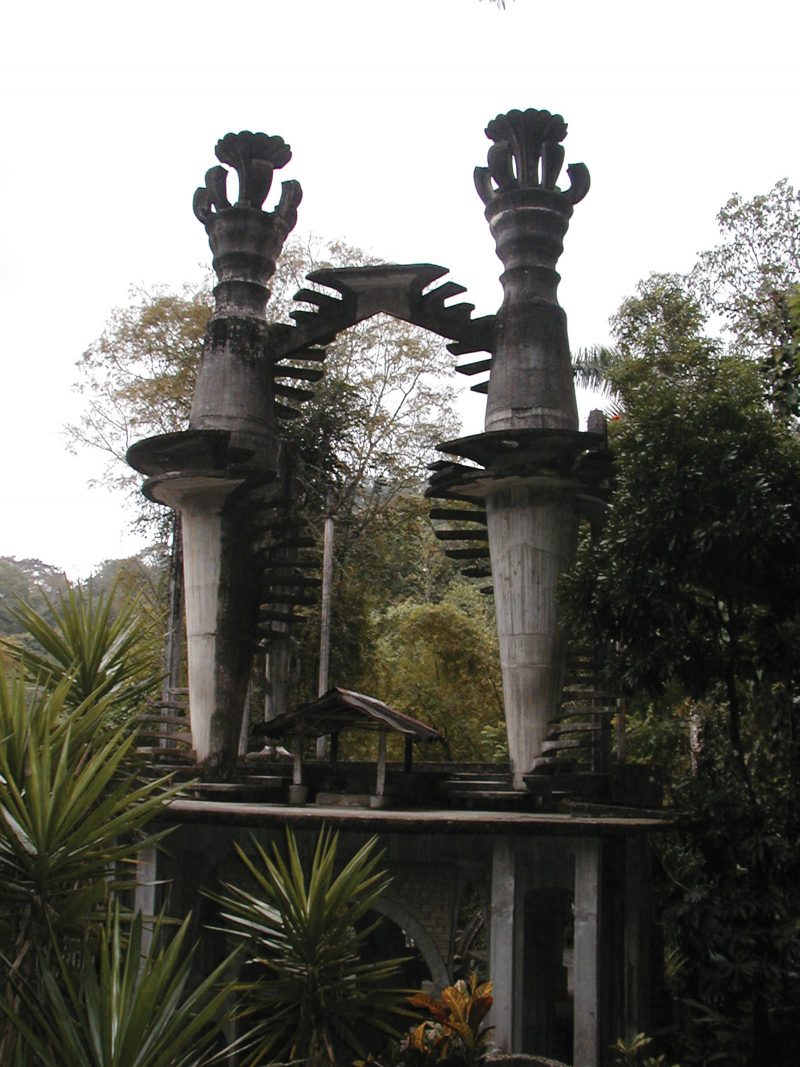
Sitting by the square, Xilitla looked like most of the small Mexican pueblos I had been to. We had come there to see what made it different: a group of sculptures located just outside of town that an amazingly wealthy and eccentric Englishman named Edward James worked on until his death, in 1984. James was born in 1907, and as a young man inherited the vast fortunes of his father, Willy, and his uncle, Frank. In the 1930s, eager to break free from his restrictive Edwardian youth, he became involved with the surrealist circles of continental Europe, and soon became a vital patron to still-struggling artists like Dalí, Magritte, and Tchelitchew. Dalí called him “crazier than all the surrealists put together.” James went on to amass a collection of surrealist art that, according to the U.K. Guardian, was at one point “the finest private collection” in the world. After a highly damaging divorce trial, he moved to Mexico in the 1940s. In Guadalajara he hired a young man named Plutarco Gastelum—who would later become James’s manager, close friend, and possibly lover—as a guide. Together, they stumbled upon the tiny town of Xilitla, hidden in the lush mountains of the Sierra Huasteca, and began building a series of fantastic, brightly colored, and highly impractical concrete structures in the jungle. This became Las Pozas (“The Pools”), a private dreamworld that James called home for the rest of his life. Reportedly, he spent five million dollars on the project, and sold many of his surrealist paintings to fund it.
I still wasn’t sure what I would make of Las Pozas. The standard guidebook entries and magazine articles I had read set the surrealistic bar pretty high: James’s “surrealist retreat,” a “surrealist labyrinth,” “the surrealistic Shangri-La.”
It was past 9 p.m. on a Saturday night, the night before Easter. We were going to see Las Pozas the next morning. There was an unusual amount of activity on Xilitla’s main square. Some sort of stage had been erected in front of the big sixteenth-century church, with microphones and speakers, multicolored stage lights, and a huge projection screen. It looked elaborate. “Maybe they’re going to do a Stations of the Cross performance,” Luis said.
“Maybe they’re going to do Jesus Christ Superstar,” I replied. We laughed.
Eventually we decided to see what the performance would be. The square was filled with hundreds of plastic folding chairs, but we had difficulty finding empty seats. On a platform next to the stage a very nontraditional band was tuning up: two electric guitars, drums, bass, a horn section, male and female backup singers in tuxedo shirts. The conductor flipped through his music nervously. Suddenly the rain stopped and the music started: heavy rock beats, wah-wah, gospel harmonies. Pixilated images of deserts rolled across the projection screen. A guy with spiky hair and a leather vest leaped onstage, belting operatically.
“What the hell is this?” I asked Luis.
“Jesuscristo Superestrella,” he replied. “Jesus Christ Superstar.”
Surrealism, it sometimes seemed to me, had grown in Mexico like the ivy I saw clinging to the walls of buildings on the streets of Xilitla—an Old World neophyte spreading its tendrils across the Mexican landscape, the capital S of the European artistic movement dissipating into the lowercase of my friends’ barroom declamations. Uprooting it, I dug back to the first days of Mexican independence. In 1840, Louis de Bellemare returned to France after spending ten years in Mexico helping with his father’s overseas business endeavors. Only nineteen years old when he arrived in Mexico, Bellemare was deeply impressed by the physical and social landscapes of the newly independent country. In 1849, he adopted the pseudonym Gabriel Ferry and began writing a series of successful adventure novels that took place in those same Mexican landscapes—“So bizarre, so picturesque, and so revolting,” George Sand would write in an introduction to Bellemare’s works. One of Ferry’s Mexican novels, Costal l’Indien, was published in 1852, the same year that he was killed when his boat caught fire on the way to San Francisco for a diplomatic mission. When André Breton, the poet and French founder of the surrealist movement, visited Mexico nearly ninety years later, he admitted that the nineteenth-century adventure novel strongly influenced his trip. Costal l’Indien was one of Breton’s favorite books as a boy growing up in the industrial suburbs of Paris—a “magic lantern” that provided the seed of his ideas about Mexico.
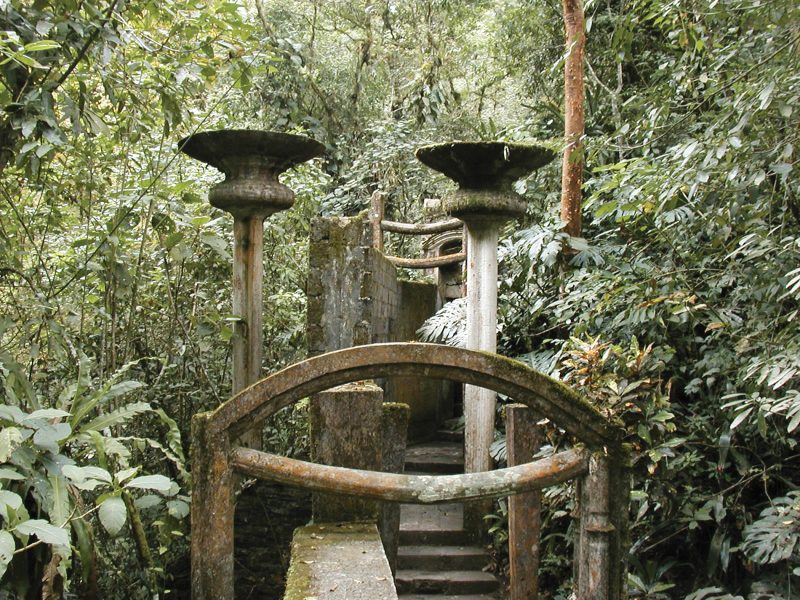
In 1908, perhaps around the time Breton was reading Ferry’s novels, Pablo Picasso organized a party to celebrate his discovery, in a junk store, of a painting by Henri “le Douanier” Rousseau. The dinner for the retiring Rousseau turned into one of the most raucous and notorious parties in art history. That night the poet Guillaume Apollinaire recited a few verses—some say he wrote them on a napkin at the dinner—in honor of le Douanier:
You recall, Rousseau, the Aztec landscape,
the forests where mango and pineapple grow…
Hereafter the brave soldier’s uniform, Rousseau,
You changed for the Douanier’s upright blue.
Rousseau hadn’t been to Mexico any more than the ancient inhabitants of Mexico’s capital had eaten mangoes. The elderly painter spent his entire life in France, and died less than two years after his banquet. But like the Spanish-introduced mango flourishing among the Aztecs’ former lands, the myth that Rousseau traveled to Mexico in his youth as part of Napoleon III’s army took hold and germinated in the imagination of the Parisian avant-garde, further cultivating Mexico’s exotic preeminence for them.
At the beginning of the 1920s, as Breton and a group of young art rebels attempted to forge an adequate successor to Dadaism, Rousseau—along with Apollinaire and Picasso—was one of the few artists of the previous two generations who earned their respect. Rousseau’s naive style and odd juxtapositions, coupled with his exotic landscapes, embodied the freedom from conventional rationality that Breton’s group embraced. The movement Breton and his group formed was surrealism, which they defined as “pure psychic automatism,” or the dictations of thought freed from reason’s restrictions. By exalting the “superior reality” of dreams, they sought to forge a new type of art and a new type of thinking that would resolve the painful restrictions of waking life. The surrealists favored spaces free from the fetishizing of logic: principally the dream state, but also childhood and—evidenced by their interest in Rousseau and later by the surrealist map—the exotic. The exotic landscape was to the surrealists a sort of waking physical dream state.
The next day, we drove down the gravel road out of Xilitla to Las Pozas. After a few minutes in the lush jungle, we saw Edward James’s animated, slightly mossed-over structures sprouting from the side of a steep hill. Wide lily-pad disks sat atop blue flower stalks, pointed with strings of concrete pearls; crowns perched on top of fernlike curlicues; arching concrete ribs supported huge, unwalled platforms; columns imitating bamboo and palm stretched twenty feet into the canopy. We saw parodies of Renaissance domes and cupolas alongside regiments of fleurs-de-lis. Things on top of other things. The Mexican landscape seems to invite fantastic, sometimes megalomaniacal architecture, from the palaces of Pacal the Great in Palenque and Moctezuma in Tenochtitlan, to the Technicolor cartoon-houses of the herbal healer Beto Ramón, just thirty kilometers from Xilitla. I couldn’t decide if Las Pozas was a surreal iteration of this tradition, or a surreal satire of it.
It was raining, so we bought ponchos and walked very carefully on the railless staircases. The map we’d bought to navigate the unmarked paths proved completely useless. Photos that looked like they had been downloaded from the internet corresponded to the names of the various structures—the House with Three Floors That in Fact Has Five, Saint Edward’s Plaza, the Cinematographer, the Flamingo House, the Bamboo Palace—but their positions on the map had no relation to reality.
What we had seen from the road was only the entrance. Paths—some neatly terraced and cobbled, some simply dirt and stones—crisscrossed the hill and led to still-wilder structures: an eye-shaped pool; vertigo-inducing, railless staircases to nowhere; arches and pillars everywhere; concrete flowers and concrete fountains with concrete water spouts. At the heart of the park was the small waterfall and natural pool from which the place takes its name.
As we clambered over the paths, we passed many Mexican tourists and a few guided tour groups. There were two or three signs in Spanish and English highlighting points from Edward James’s life—his poetry, a lifelong pursuit; his friendship with Plutarco, who oversaw so much of the construction; the importance of a carpenter from Xilitla, who built all the casts for the cement. In 2007, a foundation formed by the San Luis Potosí government, with support from CEMEX and a former CEO of Banamex (two of Mexico’s largest corporations), bought Las Pozas for $2.2 million. The foundation has begun restoring the structures, protecting them from the encroaching jungle and turning Las Pozas into a more modern, accessible site for visitors (and directors: the pop group Empire of the Sun and the singer Nicole Scherzinger both filmed music videos there after the purchase). Otherwise there was very little at Las Pozas in the way of guidance for tourists, and nothing in the way of safety precautions. Surrealist or not, Las Pozas was a very Mexican attraction, something that could never have been built in the U.S., with its stringent building codes and regulations. But in other ways, the place felt very English, like the twentieth-century equivalent of an eighteenth-century lord’s folly: the playground of a country squire with too much unearned money, grafting frills onto nature for the amusement of his garden-party guests.
André Breton’s fascination with Mexico flowered as surrealism reached its peak years. Sometime in 1934, Breton and a fellow French surrealist, the writer Roger Caillois, acquired a number of Mexican jumping beans. Breton was fixated by the beans. Caillois offered to cut one open to display the animating larvae inside, hoping to display “a form of the Marvellous that does not fear knowledge but, on the contrary, thrives on it.” But to Breton, the beans symbolized his conception of Mexico as a country where magic germinated in even the humblest vegetable, and he refused to allow Caillois to open one. The incident created a rift between the two that soon led to Caillois’s exit from the surrealist group.
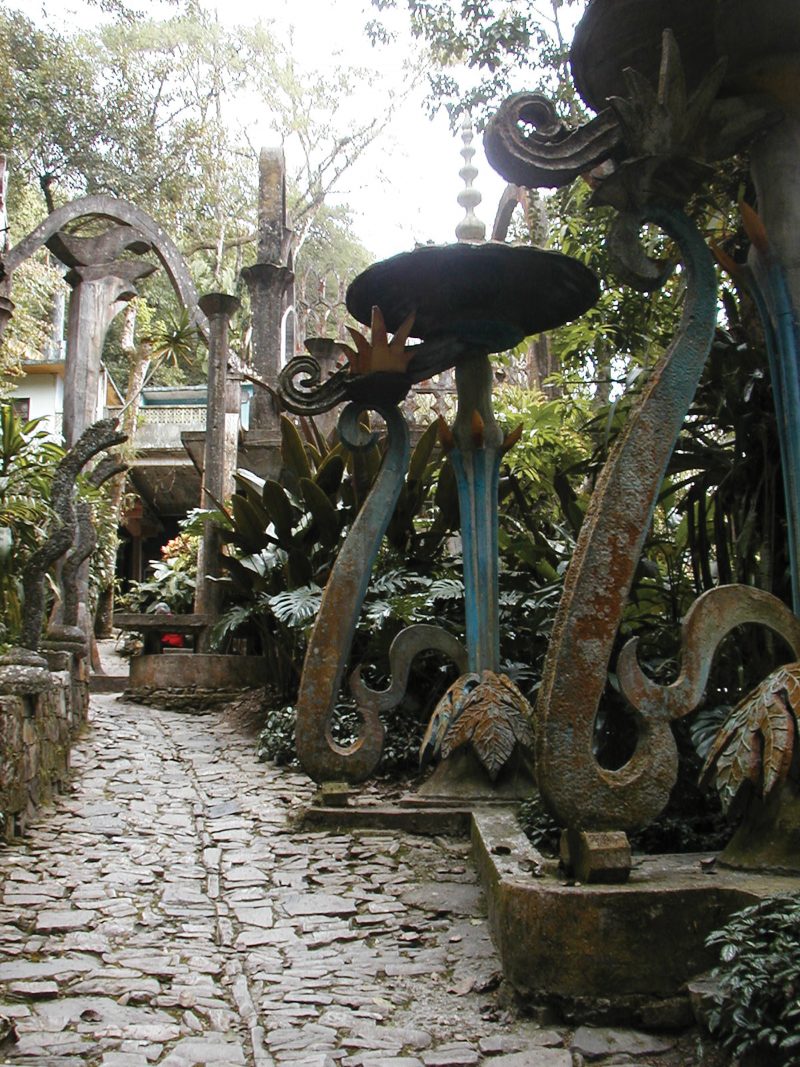
In September 1936, Luis Cardoza y Aragón, a Guatemalan writer living in Mexico City, published a letter in the newspaper El Nacional that he addressed to André Breton, in response to a request from the French writer for an “overview” of Mexican art. It seemed to confirm Breton’s impression of the Mexican landscape’s innate irrationality. “I am not used to Mexico,” Cardoza y Aragón wrote. “All is unexpected and new and permeable like the sky. Its order is reorganized every day.”
While preparing his Anthology of Black Humor that same year, Breton pointed to the Mexican woodcut artist José Guadalupe Posada as one of the most successful visual practitioners of this essential surrealist attitude. Black humor, a phrase Breton coined, had preoccupied the surrealists from the movement’s inception, since it offered the ultimate example of humor—that is, pleasure—asserting itself at precisely the moment when circumstantial reality most stands in its way. In the 1937–38 edition of Minotaure, the surrealist journal, Breton again praised Posada and called Mexico “the chosen land of black humor.”
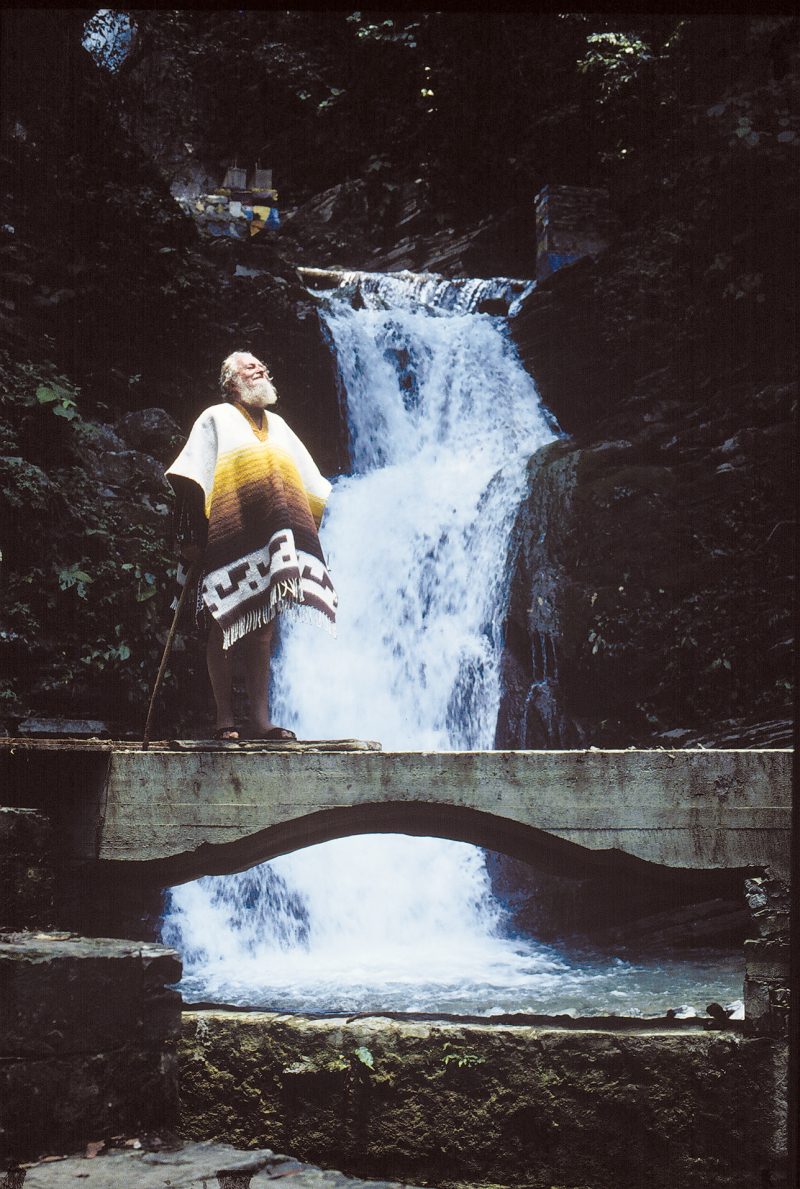
Roberto Hernández Ramírez came to Xilitla around 2007 when he heard that Las Pozas might be for sale. Plutarco Gastelum’s children had bravely maintained the site since Edward James’s death, but with almost no funding for over twenty years, they were running out of options. James had been an enthusiastic but almost willfully disorganized patron. He received thirty thousand dollars a month from his estate, and sent up to ten thousand of that to Gastelum. The rest was spent on gifts bought from Beverly Hills or West Hollywood, dinners at Trader Vic’s, or traveling. He had made no arrangements for the maintenance of Las Pozas at the time of his death. Plutarco Gastelum in turn gave Las Pozas to his son Kako as a gift. Kako tried various moneymaking schemes and greatly expanded Las Pozas’s international visibility, but lacked the means to keep up the sprawling, unfinished complex and to control the increasing stream of visitors. Meanwhile, the jungle continued its advance.
Roberto Hernández had been the youngest head of the Mexican stock exchange, and was the former CEO of Banamex, one of the country’s largest banks. Did he wonder if it was incongruous for someone like himself to take over a site like Las Pozas, an explicitly anti-practical place built by the most impractical of men? Perhaps he did, but it’s likely that Hernández had also heard about some of the other purposes Las Pozas had been turned to since Edward James’s death: an all-night rave, the setting of a junket for Mexico City bankers, an impromptu stage for a troupe of Japanese Butoh dancers. Perhaps it would be incongruous for a group of hard-nosed CEOs to purchase Las Pozas, but this was Mexico, the Fertile Crescent of incongruities. That was why Edward James had come here in the first place. If the next phase of Las Pozas’s existence was as an admission-charging park with a decent profit, or a national monument scoured by conservators and tourists, or an international center of surrealist study where academics rubbed elbows, then so be it. That was the Mexican reality, surreal as it was.
On April 18, 1938, André Breton and his wife, Jacqueline, arrived in Veracruz, Mexico, on board the Orinoco. The official purpose of Breton’s visit was to give a series of lectures. When it became clear that the French embassy had made almost no arrangements for Breton’s stay, the high priest of surrealism, enraged and carrying very little cash, threatened to return to France via the same boat he had arrived on. In the end, the Bretons were invited by Diego Rivera to stay at his house in the San Ángel neighborhood of Mexico City. An Indian servant cooked for the household, and a pet anteater rummaged in the garden. Seeing Frida Kahlo’s paintings for the first time, Breton declared her a surrealist on the spot. Kahlo denied the label and privately referred to Breton as “the old cockroach.”
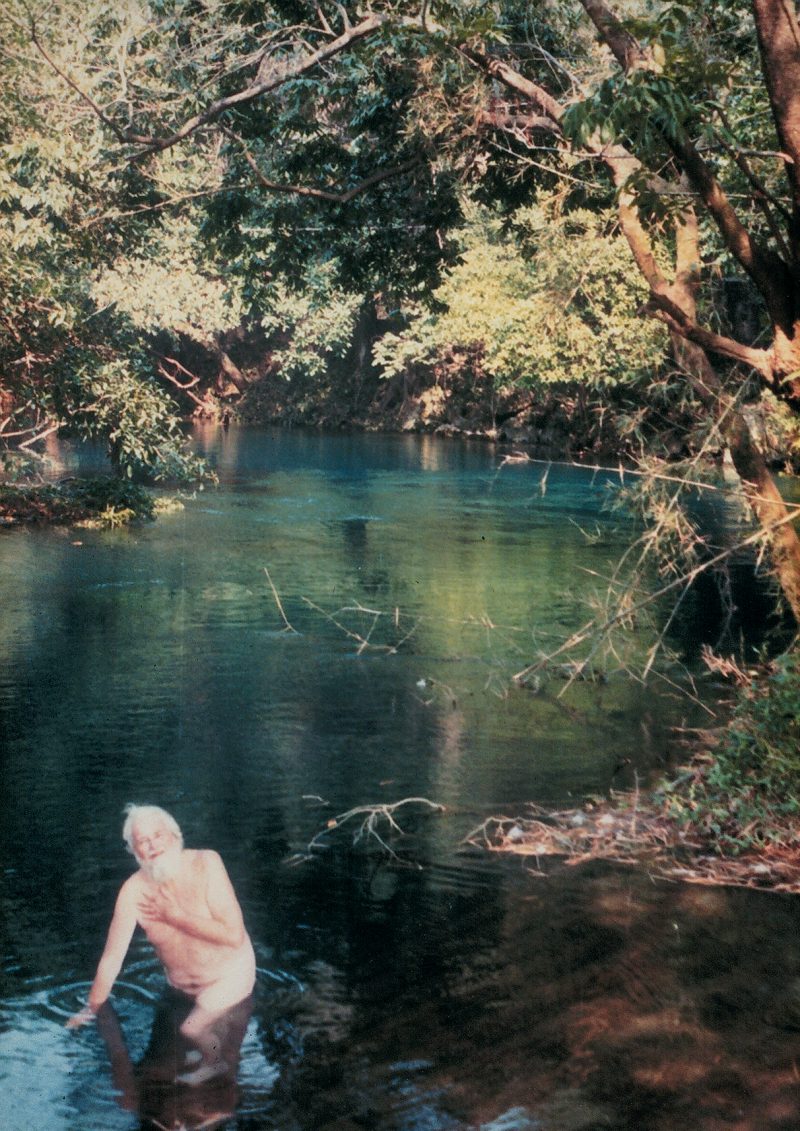
For Breton, the real purposes of the trip were meeting the exiled Leon Trotsky and collecting examples of what Breton considered Mexico’s native “surreal” arts: ex-votos, masks, pottery, dolls, sugar skulls, and wood boxes. At one point, Breton wanted a table made and gave a Mexican carpenter a perspective drawing with the desired proportions written in. After completing his work, the carpenter brought back a bizarre trapezoidal form with two long legs and two short legs. Breton was amazed. Here was a country where even humble carpenters practiced surrealistic automatism. The carpenter told the European that if he had wanted a normal table he should have asked for one.
Breton was interviewed by the writer Rafael Heliodoro Valle for the June 1939 edition of Universidad, the journal of the University of Mexico. In the interview, Breton calls Mexico “the surrealist country par excellence” and asserts that Mexico is a place with a “still active mythic past.”
Is Mexico, Valle asks, still seen by foreigners “through veils of mythology?”
No, Breton objects. What he is talking about is the real Mexico, not a myth.
Breton returned to France in August of 1938. For him, Mexico probably largely remained the territory of Costal l’Indien and sugar skulls. But for a large cluster of European surrealists, it would soon become home. Threatened by the destruction and instability of World War II—and no doubt influenced by Breton’s enthusiasm for the country—Benjamin Péret and Remedios Varo, Wolfgang Paalen and Alice Rahon, Leonora Carrington, Luis Buñuel, and Kati Horna all fled to Mexico in the 1940s. Between Breton’s pronouncements and the arrival of these visitantes fugaces, or “fleeing visitors,” Mexico had become permanently surreal.
When I was in Xilitla, I spoke to Eugenio Cabrera, a doctor who moved to the town in the 1970s to live near Las Pozas. He married Plutarco Gastelum’s daughter, Gabriela, and knew Edward James.
“I think Mexico has something surrealist in its essence,” he told me. “Something schizophrenic, disconnected from reality. We Mexicans aren’t very subject to a linear form of thinking. So surrealist things often emerge—sometimes for good, sometimes not. Now globalization is leveling everything, but before, Mexico was pretty magical. It still has sparks, marvelous sparks. The fact that Las Pozas is here in Mexico, that gives you a clue. In what other part of the world would people not stop to ask, ‘What is this? What’s it for?’ When you asked the workers here, ‘What’s he making?’ they would say, ‘Well, really nice arches, staircases.’ ‘What for?’ ‘Not for anything.’ People took it as something natural. That’s what Edward James liked about Mexico, too.”
About a month after visiting Las Pozas, I spoke to Barbara Hernández, sister of Roberto Hernández and cofounder of the foundation that purchased Las Pozas in 2007. We talked for a while about the foundation’s plans, and then I asked if Roberto had a special interest in surrealism.
“Not specifically,” she said. “But we live in a surrealist country, no?”
“People say that a lot,” I answered. “What do you mean, exactly?”
“Many things,” she said. “It’s magical. Like any time you go to a government place to do things, you say, ‘This is surreal.’ Or just today, I was at a restaurant I have in the city, and they told me they were going to shut off the energy. But not because I haven’t paid, but because of their own problem.”
“Isn’t that just the Mexican reality?”
“That’s the Mexican reality, but sometimes you think, That can’t be real. I’ve heard that Dalí came and he said, ‘I don’t like Mexico—it’s too surrealistic.’”
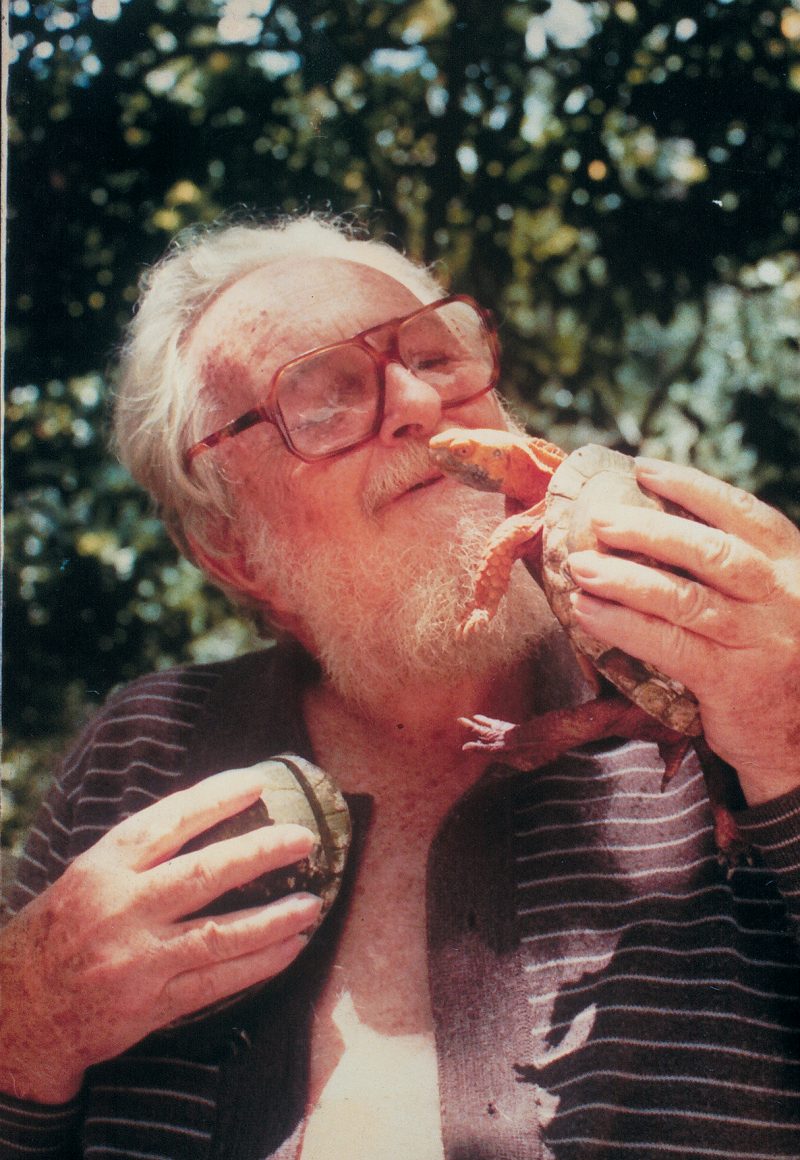
Anyone who spends enough time in Mexico is bound to hear someone label it a surrealist country. College kids here say it, doctors say it, it pops up in your Lonely Planet. They point to the distinctly Mexican taste for kitsch, or the color and chaos of popular religious customs here, or just to humorous urban coincidences. A Mexico City lawyer once asked me if I’d seen all the clowns walking around—they’re a popular form of street entertainment in the capital. Then he gestured excitedly toward the window of his office. “This is a surrealist city!” he insisted. “You could look out that window and see an elephant walking through the courtyard!”
The sheer volume of striking incongruities on display here does at times suggest that Mexico is a surreal country, or even that Breton’s conception of Mexico as the “surrealist country par excellence” is apt. But what if, as a child, Breton had picked up H. Rider Haggard’s African adventure novels instead of Costal l’Indien? What if Apollinaire had written a poem about Henri Rousseau traveling to Indochina instead of to Mexico? To an outsider, there is no shortage of locales that present themselves as Mexico’s surrealistic equals: Australia, Hong Kong, Brazil, Mongolia. Anyone who travels in unfamiliar terrain will inevitably find the everyday to be illogical and discrepant, which is why the surrealists placed such value on the less-explored territories of the globe in their world map.
What remains unsettling is the fact that people who are familiar with Mexico insist on calling it surreal. In Mexico, the word surreal has moved beyond anything resembling an art-historical term. It has even moved beyond the casual U.S. usage of the word as a synonym for dreamlike or absurd. After speaking to Barbara Hernández, I realized that in Mexico surreal has become a sort of catchall term for infrastructural inconveniences and administrative snares. It offers a way to shrug off or sublimate circumstances and situations that everyone knows could be fixed if Mexico’s government and business environment were different. Whereas the surrealists originally hoped they could provide a method by which the freedom of dream processes could resolve the restrictions of reality, this insistence on Mexico’s “surreality” suggests a place that is overwhelmed and trapped by its own reality. It’s as if some Mexicans have gotten tired of listing all the real problems their country faces—corruption, infrastructural failures, poverty—and find the label the surrealists loaned them as a convenient outlet for escapism. Most people won’t use words like inefficient, unreliable, or classist when they can simply say surreal.
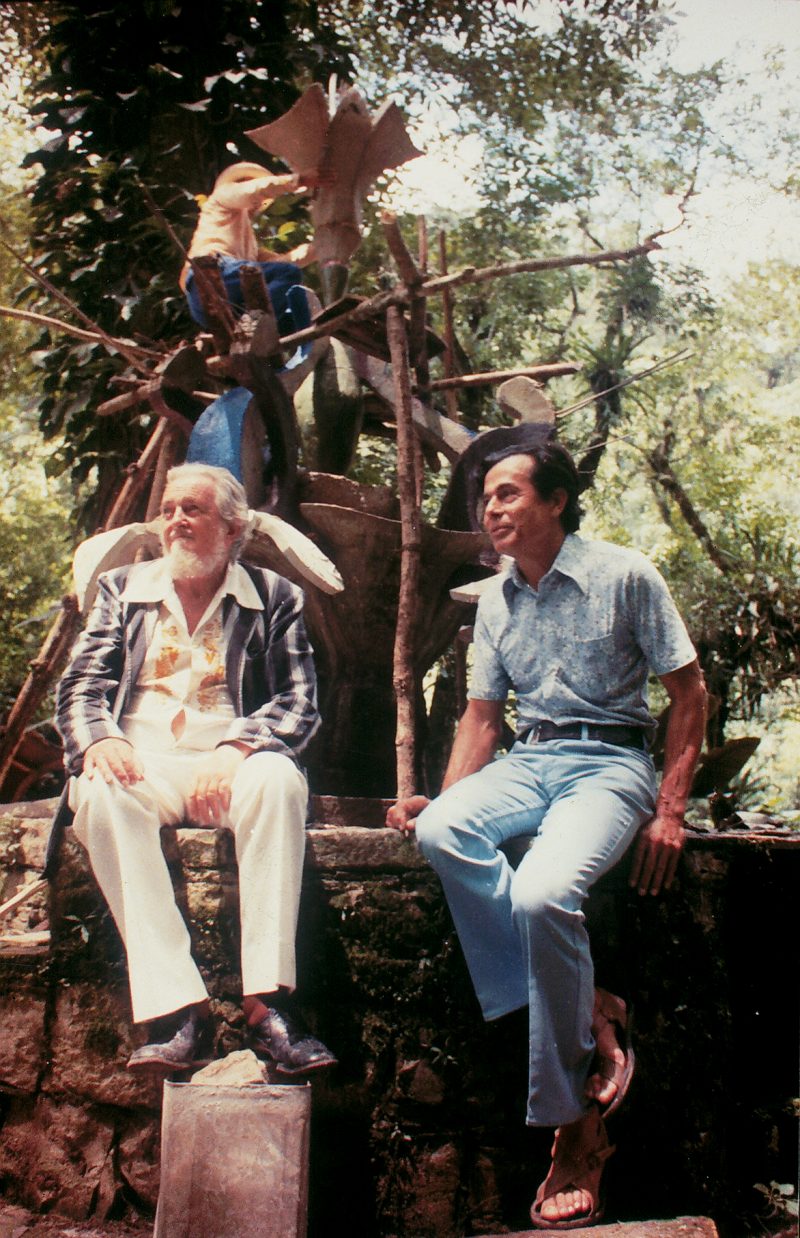
Edward James is sometimes grouped with those surrealists who fled to Mexico during World War II. But James was never part of Breton’s group, and thought of himself primarily as a poet and patron, not an artist. He originally came to Xilitla for orchids. It was 1945, and he was traveling with a friend, Roland McKenzie. An orchid grower had told them that amazing specimens could be found near the isolated mountain town of Xilitla. Coming to the small waterfall outside of the town, James and McKenzie decided to go skinny-dipping. According to a story James loved to retell throughout the rest of his life, McKenzie was emerging from the water when a cloud of blue butterflies blanketed his naked body. James took this as a sign that he was destined for the place, which would become Las Pozas.
Much later, journalists and film directors would often say that the ungentlemanly scandal unleashed by his divorce suit against his wife drove James from England. In fact, James left several years after the divorce, at the start of World War II. James found convenient excuses for not joining the RAF, and, after the war, tax problems would prevent him from living in England for more than a quarter of each year. He had tried to make his home in London and Rome, and in the 1930s he had even converted one of his inherited English properties into a deliberately surrealist funhouse with the help of Salvador Dalí. He spent the first half of the 1940s in California, unsuccessfully trying to break into the expat spiritualist community of Aldous Huxley, Christopher Isherwood, and Gerald Heard. He never stayed very long in any of these places.
A freak snowstorm destroyed the orchid garden in 1962. Instead of replanting, James simply moved on to another project: creating concrete trees and plants that, as he put it, “couldn’t be killed by freak weather,” and building elaborate cages for his growing collection of exotic animals. This was the real impetus behind the concrete structures at Las Pozas. But even as his Mexican dreamscape grew, James continued to spend the majority of each year in California, Europe, and Mexico City. Most of the work at Las Pozas fell to Gastelum. As it turned out, James loved collecting animals but was terrible at keeping them. Parrots died of sunstroke during the long train trip to Xilitla, and a pair of baby alligators expired after being photographed with James.
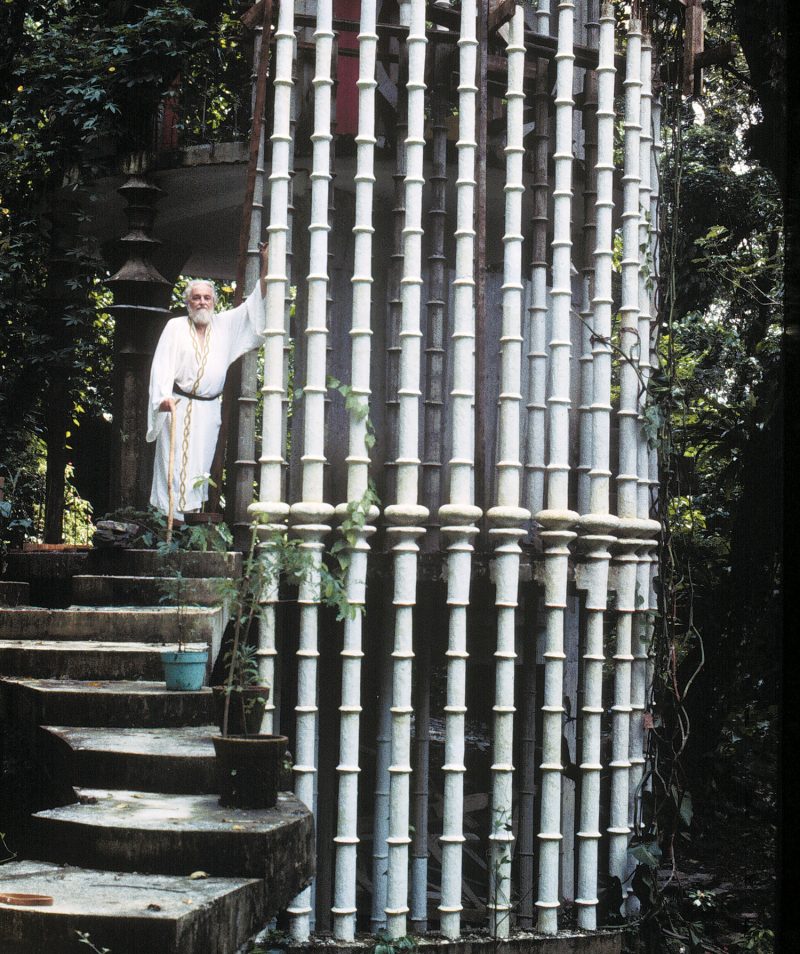
© 1979 by Luis Felix. Courtesy of xilitla.org/booksanddvds.php.
Photos taken during the construction of Las Pozas picture James as a kind of tropicalized eccentric: shaggy and white-haired, wearing an old Eton blazer, a parrot perched on his shoulder, basking in the sun atop one of his sculptures, or being carried up and down the mountainside on a homemade sedan chair, at home in his Mexican surrealist playground. Biographers and journalists would later argue that the quest into the surreal that eventually brought James to Mexico was an attempt to break away from the Edwardian mores of his pampered childhood. But if you had spoken to one of the Xilitlan villagers who toiled on James’s sculptures or carried his sedan chair, I doubt they would have agreed with Breton’s pronouncement of 1939 or Barbara Hernández’s of 2012—the suggestion that they lived in a surreal or even fantastical country. To them, a visit to James’s childhood would have been the most surreal tourist jaunt imaginable—more so than any structure from Las Pozas, any Dalí painting or “naive” Mexican ex-voto: his parents’ famously extravagant weekend garden parties, full of royal guests; his father’s incessant pheasant hunting; his mother in whalebone corsets and sables and parma violets, covered all over in jewels—things on top of other things, according to the current fashion; her elaborate party tricks (she was once presented as a life-size doll that suddenly jumped out of its box, to her guests’ amazement); his uncle’s death beneath the feet of a rampaging elephant during an African safari. From a distance, it all appears dreamlike, almost impossible. Even stories of James’s birth contain an absurd element. Some members of British high society whispered that he might have been the bastard son of King Edward VII, or that his mother was in fact the king’s daughter, or at the very least that an attack of the mumps had left his official father, Willy, impotent. As an adult, James complained bitterly of his loveless upbringing, but at the same time he used his immense wealth to turn his life into a sort of never-ending, portable garden party, with artists and intellectuals substituting for royalty.
And so James decided Mexico would become the newest setting in his life of eternal entertainment. For James, Mexico was a reality apart, not a European fantasy, as it had been for Breton, or a cultural house of mirrors, as it is viewed by many people who throw around the term surreal today. And it was a reality that suited James: somewhat romantic and wild, and almost free of rules—or at least free of zoning boards. In Mexico, fantastical dreamscapes could be built into reality, if one had the money and the patience. As I would see sixty years later, it is also a place where dreamscapes easily collapse. The moss and humidity continue to corrode Las Pozas’s concrete structures, while the water of the falls shifts their foundations. During his lifetime, James reveled in the idea that his sculptures would one day be consumed by the jungle, swallowed by the ultimate reality of the Mexican landscape, just like the ancient marvels of the Olmec and the Maya. Today, James’s inheritors pour new fortunes into halting the encroaching jungle, in the name of preserving surrealism. It is absurd, maybe even hopeless work, but it is all part of the Mexican reality. And I don’t think Edward James, for one, ever called Mexico surreal.




